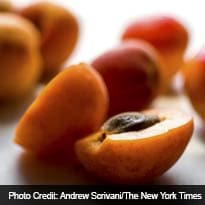A pie is homey. A tart is fancy. And a galette splits the difference, but it is easier than either one. The defining factor of a galette (which can also be called a crostata if you've got Italian inclinations) is that it's a free-form pastry, baked without the stability of a pie pan or tart ring. The dough is rolled out flat, then folded around the filling. The appeal of a galette lies in its rusticity. Its juices can leak, the pastry can tear, the filling can singe at the top; it doesn't matter. As long as you've used good fruit or vegetables for the filling and real butter for the dough, it will bake up into something golden brown and utterly gorgeous, the kind of pastry you're happy to whip up anytime, not just on special occasions.For the novice baker, mastering a forgiving galette before trying pies and tarts will give you confidence. For the baking expert, galettes offer ample opportunity for personal expression. Once you have the basic formula down, you can change it up to suit your tastes, the fruit in season, the leftover vegetables in your fridge. This is why everyone should have a go-to galette recipe to call on when a craving for pastry hits. Here is mine.
The foundation of any good galette is its crust. You can use any dough recipe as long as it's sturdy enough to handle without breaking. I've included two variations here on the same basic dough. The first is cookie-like, using sugar and white all-purpose flour to keep it delicate and flaky. It's perfect for fruit-filled galettes.The other has less sugar and uses whole-grain flour (rye or whole-wheat) to give it a nubby, hearty texture and more pronounced flavor. I like this to anchor savory vegetable galettes. But you can switch these up if you'd rather. Just dial down the sugar if you want to use the white flour dough for vegetables.And when it comes to fruit, the riper, the better. Galettes are a perfect place to use up all that soft, weeping fruit on your counter. Or if you're stuck with underripe fruit that needs a flavor boost, paint the rolled-out pastry with jam before adding the filling. Always sweeten your fruit to taste. Plums tend to need a lot of sugar, figs barely any. Add the sugar gradually, tasting as you go.I like cornstarch as a thickener because it's easy to find and simple to use. Just make sure the filling bubbles up vigorously as it bakes to activate its thickening power, otherwise you'll end up with soggy pastry filled with fruit soup. Use more cornstarch for particularly juicy fruits (stone fruits like peaches, plums and nectarines) and less for pectin-rich, drier fruit like figs and blueberries.You don't need any thickener for a savory galette, as long as you cook any vegetables before adding them to the crust. Here, I've roasted eggplant, zucchini and tomatoes, which I spread over thyme and garlic-flecked goat cheese. Savory galettes are a terrific place to use up any leftover cooked vegetables. Feel free to add cheese, cooked bacon and crumbled sausage as you see fit.Whether you go savory or sweet, you'll need about three cups of filling for a standard dough recipe. But don't worry about any of this too much. Because the fact of it is, anything that tastes good on its own will probably taste even better baked inside a buttery pastry. And there's no better place for it than a versatile galette.Fruit Galette
Time: 2 hours, plus at least 2 hours' chilling
Yields: 8 servings
For the dough:
1 1/3 cups/165 grams all-purpose flour
1 tablespoon/15 grams sugar
1/2 teaspoon/3 grams fine sea salt
1 large egg
Heavy cream, as needed
1 stick/113 grams unsalted butter, cut into big pieces
2 teaspoons/10 milliliters lemon juice
1/2 teaspoon/4 grams grated lemon zest (optional)
For the filling:
3 cups summer fruit of your choice (berries, stone fruit, figs), sliced or cubed if necessary
1/2 cup to 3/4 cup/100 to 150 grams sugar, to taste
Pinch of salt
Juice and grated zest of 1/2 lemon (optional)
3 to 4 tablespoons/25 to 35 grams cornstarch1. Make the crust: In a food processor fitted with a steel blade, or in a large bowl, pulse or mix together flour, sugar and salt. In a measuring cup, lightly beat the egg, then add just enough cream to get to 1/3 cup. Lightly whisk the egg and cream together.
2. Add butter to flour mixture and pulse or use a pastry cutter or your fingers to break up the butter. If using a food processor, do not over-process; you need chickpea-size chunks of butter. Drizzle the egg mixture (up to 1/4 cup) over the dough and pulse or stir until it just starts to come together but is still mostly large crumbs. Mix in lemon juice and zest if using.
3. Put dough on lightly floured counter and pat it together to make one uniform piece. Flatten into a disk, wrap in plastic and chill for 2 hours, or up to 3 days.
4. Heat the oven to 400 degrees. Roll the dough out to a 12-inch round (it can be ragged). Transfer to a rimmed baking sheet lined with parchment paper and chill while preparing the filling.
5. Make the filling: Toss together fruit, all but a tablespoon of sugar, the salt, the lemon juice and zest, and the cornstarch. Use more cornstarch for juicy stone fruit and less for blueberries, raspberries and figs. Pile fruit on the dough circle, leaving a 1 1/2-inch border. Gently fold the pastry over the fruit, pleating to hold it in (sloppy is fine). Brush pastry generously with leftover egg and cream mixture. Sprinkle remaining sugar on the crust.
6. Bake for 35 to 45 minutes, until the filling bubbles up vigorously and the crust is golden. Cool for at least 20 minutes on wire rack. Serve warm or at room temperature.
Summer Vegetable Galette
Time: 2 hours, plus at least 2 hours' chilling
Yield: 8 servings
For the dough:
2/3 cup/80 grams all-purpose flour
2/3 cup/90 grams rye flour or whole-wheat flour
1 teaspoon/5 grams sugar
1/2 teaspoon/3 grams fine sea salt
1 large egg
Heavy cream, as needed
1 stick/113 grams unsalted butter, cut into big pieces
2 teaspoons/10 milliliters lemon juice
1/2 teaspoon/4 grams grated lemon zest (optional)
For the filling:
2 medium eggplant (about 1 pound), trimmed and thinly sliced
2 medium zucchini (about 3/4 pound), trimmed and thinly sliced
1 pound plum tomatoes, cored and thinly sliced
Extra-virgin olive oil, as needed
Kosher salt, as needed
Black pepper, as needed
2 hot chili peppers, such as cherry peppers, seeded and minced
3 ounces goat cheese, softened
1 small garlic clove, grated or pressed
1 teaspoon thyme leaves1. Make the crust: In a food processor fitted with a steel blade, or in a large bowl, pulse or mix together the flours, sugar and salt. In a measuring cup, lightly beat the egg, then add just enough cream to get to 1/3 cup. Lightly whisk the egg and cream together.
2. Add butter to flour mixture and pulse or use a pastry cutter or your fingers to break up the butter. If using a food processor, do not over-process; you need chickpea-size chunks of butter. Drizzle the egg mixture (up to 1/4 cup) over dough and pulse or stir until it just starts to come together. Mix in lemon juice and zest.
3. Put dough on lightly floured counter. Knead into one uniform piece. Flatten into disk, wrap in plastic and chill for 2 hours, or up to 3 days.
4. When you are ready to make the tart, roll out dough to a 12-inch round (it can be ragged). Transfer to a rimmed baking sheet lined with parchment paper and chill while preparing the filling.
5. Heat oven to 425 degrees. Spread out eggplant, zucchini and tomatoes in one layer on 3 separate sheet pans or baking sheets. Drizzle generously with oil and season with salt and pepper. Roast vegetables, tossing zucchini and eggplant occasionally, 35 to 40 minutes. Eggplant and tomatoes will be golden at the edges; zucchini will be tender. Don't let the vegetables get too dark because they will continue to brown in the tart. Transfer vegetables to a bowl (you want to have about 3 cups of them) and toss with chili peppers.
6. Decrease oven temperature to 400 degrees. In a small bowl, combine goat cheese, garlic and thyme leaves. Spread mixture in a thin layer over crust, leaving a 1 1/2-inch border all around. Arrange vegetables evenly over goat cheese. Fold up edges of crust, pleating to hold it in (sloppy is fine). Brush pastry generously with leftover egg and cream mixture.
7. Transfer galette to oven and bake until golden brown, about 40 minutes. Cool on a wire rack for at least 20 minutes before slicing.© 2014 New York Times News Service
The foundation of any good galette is its crust. You can use any dough recipe as long as it's sturdy enough to handle without breaking. I've included two variations here on the same basic dough. The first is cookie-like, using sugar and white all-purpose flour to keep it delicate and flaky. It's perfect for fruit-filled galettes.The other has less sugar and uses whole-grain flour (rye or whole-wheat) to give it a nubby, hearty texture and more pronounced flavor. I like this to anchor savory vegetable galettes. But you can switch these up if you'd rather. Just dial down the sugar if you want to use the white flour dough for vegetables.And when it comes to fruit, the riper, the better. Galettes are a perfect place to use up all that soft, weeping fruit on your counter. Or if you're stuck with underripe fruit that needs a flavor boost, paint the rolled-out pastry with jam before adding the filling. Always sweeten your fruit to taste. Plums tend to need a lot of sugar, figs barely any. Add the sugar gradually, tasting as you go.I like cornstarch as a thickener because it's easy to find and simple to use. Just make sure the filling bubbles up vigorously as it bakes to activate its thickening power, otherwise you'll end up with soggy pastry filled with fruit soup. Use more cornstarch for particularly juicy fruits (stone fruits like peaches, plums and nectarines) and less for pectin-rich, drier fruit like figs and blueberries.You don't need any thickener for a savory galette, as long as you cook any vegetables before adding them to the crust. Here, I've roasted eggplant, zucchini and tomatoes, which I spread over thyme and garlic-flecked goat cheese. Savory galettes are a terrific place to use up any leftover cooked vegetables. Feel free to add cheese, cooked bacon and crumbled sausage as you see fit.Whether you go savory or sweet, you'll need about three cups of filling for a standard dough recipe. But don't worry about any of this too much. Because the fact of it is, anything that tastes good on its own will probably taste even better baked inside a buttery pastry. And there's no better place for it than a versatile galette.Fruit Galette
Time: 2 hours, plus at least 2 hours' chilling
Yields: 8 servings
For the dough:
1 1/3 cups/165 grams all-purpose flour
1 tablespoon/15 grams sugar
1/2 teaspoon/3 grams fine sea salt
1 large egg
Heavy cream, as needed
1 stick/113 grams unsalted butter, cut into big pieces
2 teaspoons/10 milliliters lemon juice
1/2 teaspoon/4 grams grated lemon zest (optional)
For the filling:
3 cups summer fruit of your choice (berries, stone fruit, figs), sliced or cubed if necessary
1/2 cup to 3/4 cup/100 to 150 grams sugar, to taste
Pinch of salt
Juice and grated zest of 1/2 lemon (optional)
3 to 4 tablespoons/25 to 35 grams cornstarch1. Make the crust: In a food processor fitted with a steel blade, or in a large bowl, pulse or mix together flour, sugar and salt. In a measuring cup, lightly beat the egg, then add just enough cream to get to 1/3 cup. Lightly whisk the egg and cream together.
2. Add butter to flour mixture and pulse or use a pastry cutter or your fingers to break up the butter. If using a food processor, do not over-process; you need chickpea-size chunks of butter. Drizzle the egg mixture (up to 1/4 cup) over the dough and pulse or stir until it just starts to come together but is still mostly large crumbs. Mix in lemon juice and zest if using.
3. Put dough on lightly floured counter and pat it together to make one uniform piece. Flatten into a disk, wrap in plastic and chill for 2 hours, or up to 3 days.
4. Heat the oven to 400 degrees. Roll the dough out to a 12-inch round (it can be ragged). Transfer to a rimmed baking sheet lined with parchment paper and chill while preparing the filling.
5. Make the filling: Toss together fruit, all but a tablespoon of sugar, the salt, the lemon juice and zest, and the cornstarch. Use more cornstarch for juicy stone fruit and less for blueberries, raspberries and figs. Pile fruit on the dough circle, leaving a 1 1/2-inch border. Gently fold the pastry over the fruit, pleating to hold it in (sloppy is fine). Brush pastry generously with leftover egg and cream mixture. Sprinkle remaining sugar on the crust.
6. Bake for 35 to 45 minutes, until the filling bubbles up vigorously and the crust is golden. Cool for at least 20 minutes on wire rack. Serve warm or at room temperature.
Summer Vegetable Galette
Time: 2 hours, plus at least 2 hours' chilling
Yield: 8 servings
For the dough:
2/3 cup/80 grams all-purpose flour
2/3 cup/90 grams rye flour or whole-wheat flour
1 teaspoon/5 grams sugar
1/2 teaspoon/3 grams fine sea salt
1 large egg
Heavy cream, as needed
1 stick/113 grams unsalted butter, cut into big pieces
2 teaspoons/10 milliliters lemon juice
1/2 teaspoon/4 grams grated lemon zest (optional)
For the filling:
2 medium eggplant (about 1 pound), trimmed and thinly sliced
2 medium zucchini (about 3/4 pound), trimmed and thinly sliced
1 pound plum tomatoes, cored and thinly sliced
Extra-virgin olive oil, as needed
Kosher salt, as needed
Black pepper, as needed
2 hot chili peppers, such as cherry peppers, seeded and minced
3 ounces goat cheese, softened
1 small garlic clove, grated or pressed
1 teaspoon thyme leaves1. Make the crust: In a food processor fitted with a steel blade, or in a large bowl, pulse or mix together the flours, sugar and salt. In a measuring cup, lightly beat the egg, then add just enough cream to get to 1/3 cup. Lightly whisk the egg and cream together.
2. Add butter to flour mixture and pulse or use a pastry cutter or your fingers to break up the butter. If using a food processor, do not over-process; you need chickpea-size chunks of butter. Drizzle the egg mixture (up to 1/4 cup) over dough and pulse or stir until it just starts to come together. Mix in lemon juice and zest.
3. Put dough on lightly floured counter. Knead into one uniform piece. Flatten into disk, wrap in plastic and chill for 2 hours, or up to 3 days.
4. When you are ready to make the tart, roll out dough to a 12-inch round (it can be ragged). Transfer to a rimmed baking sheet lined with parchment paper and chill while preparing the filling.
5. Heat oven to 425 degrees. Spread out eggplant, zucchini and tomatoes in one layer on 3 separate sheet pans or baking sheets. Drizzle generously with oil and season with salt and pepper. Roast vegetables, tossing zucchini and eggplant occasionally, 35 to 40 minutes. Eggplant and tomatoes will be golden at the edges; zucchini will be tender. Don't let the vegetables get too dark because they will continue to brown in the tart. Transfer vegetables to a bowl (you want to have about 3 cups of them) and toss with chili peppers.
6. Decrease oven temperature to 400 degrees. In a small bowl, combine goat cheese, garlic and thyme leaves. Spread mixture in a thin layer over crust, leaving a 1 1/2-inch border all around. Arrange vegetables evenly over goat cheese. Fold up edges of crust, pleating to hold it in (sloppy is fine). Brush pastry generously with leftover egg and cream mixture.
7. Transfer galette to oven and bake until golden brown, about 40 minutes. Cool on a wire rack for at least 20 minutes before slicing.© 2014 New York Times News Service
Advertisement













